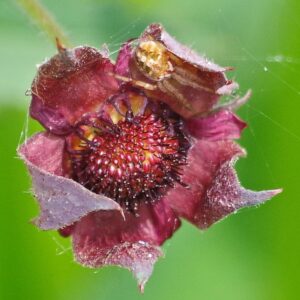Note: All links leave to external sites.
Greetings, BugFans,
The BugLady has written several times about the big orb weaving spiders that either delight or alarm people in the waning days of summer. Because there may be several hundred eggs packed into a single egg sac, the spiders were seriously tiny when they started their journeys in late spring, but after being on the landscape all summer, they grew big enough to be noticed.
Our previous orbweavers have been in the genus Argiope (the Banded and the Black and Yellow Argiope), and in the genus Araneus (the Shamrock, the Cross, and the BugLady’s favorite, the Marbled orbweaver. Arabesque orbweavers are in the genus Neoscona, the Spotted orbweavers (and there’s even a species of Spotted orbweaver named the Spotted orbweaver, Neoscona domiciliorum). There are eight species in the genus throughout North America and more in tropical climes around the world.
As a group, the Neoscona spiders tend to be hairy, spiny-legged,
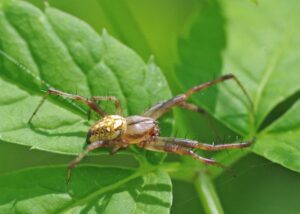
and well-camouflaged rather than gaudy. The front set of legs is longest, then the second, and then the fourth, and the third set is shortest. Most species of Neoscona are not as big as the Araneus and Argiope spiders, but they sometimes resemble the Araneus orbweavers. According to the Missouri Department of Conservation website, “some are quite difficult to distinguish, even by specialists. Often, you must observe small details of their anatomy in order to determine the species” (by which they mean the naughty-bits). They usually spin vertical trap webs that are described as “delicate.”
Arabesque orbweavers (Neoscona arabesca) are in the spider family Araneidae, the orbweavers. The BugLady found two explanations of the origin of the name “Arabesque.” Less likely, she thinks, is the comparison of the movements of a web-spinning spider to those of a ballet dancer. More likely, from a Missouri Department of Conservation online Field Guide, is that the name refers to the swirling pattern on the dorsal (top) side of the abdomen, which “resembles the ornate, flowery, interlacing patterns of Arabic or Moorish decoration (think of the patterns in Islamic art, such as on oriental rugs, or in the decorative architecture of mosques).”
Brief Aside: Around the time of the First Contact, the words “Turkey” and “Turkish” were buzzwords in Europe for the “strange” and “exotic” and were often applied to imports that came from the Orient. This explains the name of our Turkey birds, some of which were taken from the New World to the Old, to the amazement of all, in the great initial exchange of plants and animals that followed the “discovery” of this continent. It’s unclear whether explorers transported our standard Wild Turkey or the spectacular Central American Ocellated Turkey.
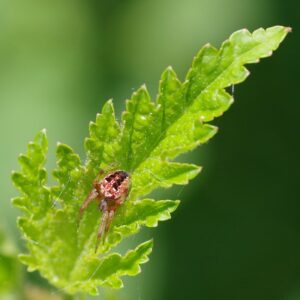
Arabesque orbweavers are found in grasslands, woodlands, and edges, and in gardens and on the outsides of buildings over most of the US and Canada and south into Central America (and they are listed on a website about Dutch Caribbean animals). One blog listed the Arabesque orbweaver as the most common in its genus and one of the more common orbweavers overall.
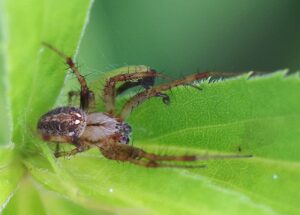
Females are larger and rounder than males. The body of a female may reach a half-inch long with a leg span of about 1 ¼” and bugguide.net says that the pairs of slanted, black “commas” on the top of the abdomen are good field marks (the BugLady always sees the white “headlights” first, but those are not as apparent on all individuals). They can vary in color from black to blonde.
Females build trap webs that measure between 6” and 18” across, and males wander around the countryside searching for edibles and for females. During the night, she rests in the middle of the web, her abdomen poked through a gap at its center, ready to pounce on, paralyze, and wrap any moths or flies that get stuck in it (several sources mentioned that Arabesque orbweavers catch a lot of crane flies).
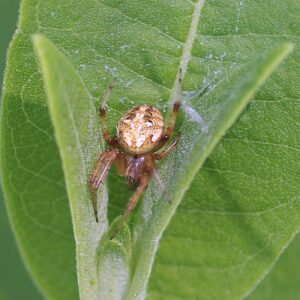
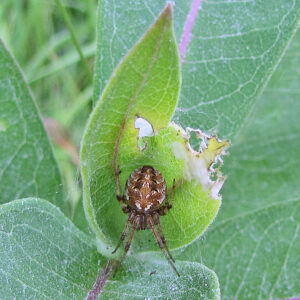
During the day, she hides in the vegetation, often within a curled leaf that she has webbed shut. Arabesque orbweavers are eaten by predators, and their egg sacs make good winter food for birds that can find them. They’re also targeted by an Ichneumon wasp called Acrotaphus wiltii that lays her egg on a spider and leaves the eventual larva to feed on its victim’s exterior.
After a night of being struck by insects, her web is pretty frayed, so when the sun comes up, she eats it and the dew that has collected on it rather than repairing it (as some spiders do). Her silk is made up of complex proteins that she will break down and reuse when she makes her new web at dark. Another advantage of destroying her web is that she gets rid of a very visible advertisement of her presence. As the “Plants and Animals of Northeast Colorado” website says, if you want to see her, you should go out after dark with a flashlight.
Missouri folk wisdom tells us that if you walk through a web across a trail, expect a letter in the mail.
The BugLady
